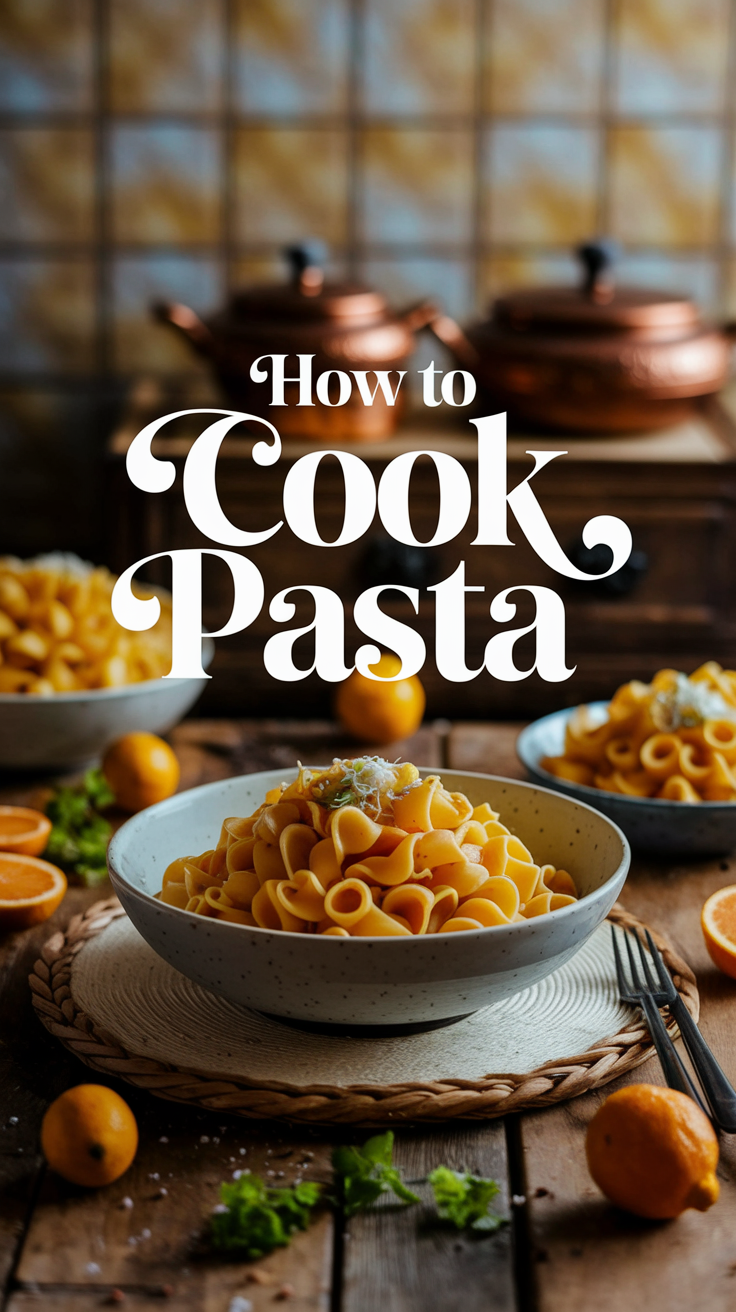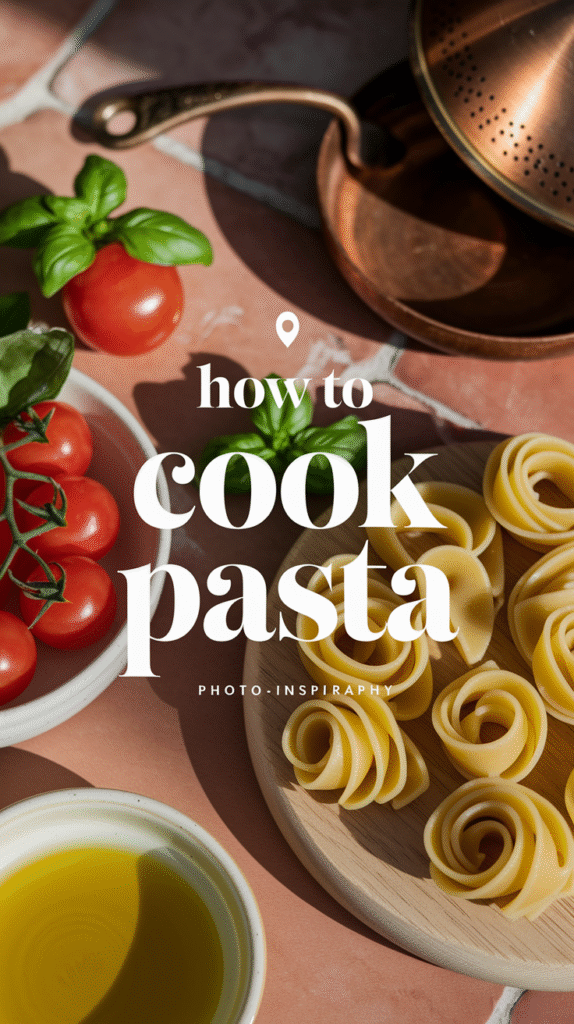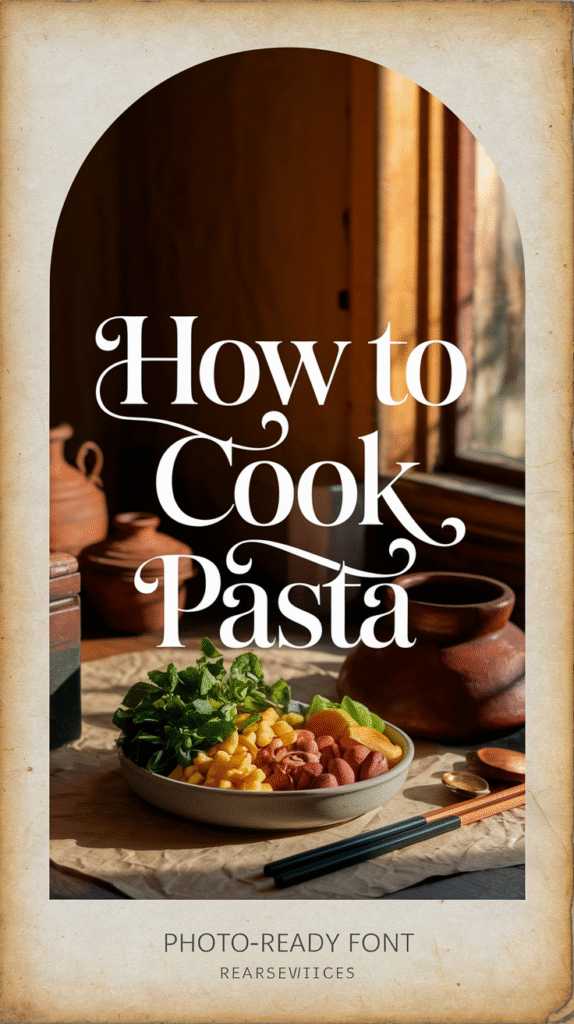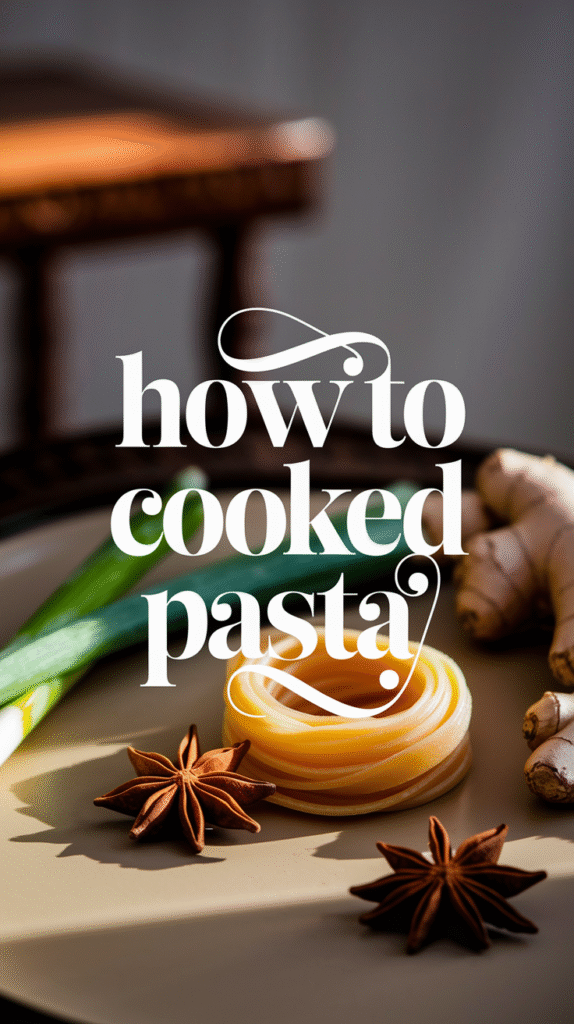Cooking pasta is an art that can elevate a simple meal into a delightful experience. By following essential steps, you can achieve perfectly cooked pasta every time. Whether you prefer it al dente or softer, the process remains generally the same. Let’s walk you through the steps that will guarantee a delicious pasta dish.
Choosing the Right Pasta
The first step in cooking pasta is selecting the right type. There are various kinds, including:
- Spaghetti: Long and thin, perfect for sauces like marinara.
- Penne: Tube-shaped, great for baked dishes.
- Fusilli: Spiral-shaped, capturing sauces well.
- Fettuccine: Flat and wide, typically paired with creamy sauces.
Consider what sauce you will use and choose a pasta shape that complements it.
Gathering Your Ingredients
Before you start, make sure you have the following:
- Water
- Salt
- Your chosen pasta
- Olive oil (optional)
Boiling Water
Fill a large pot with water and set it on high heat. Aim for about 4 to 6 quarts of water for every pound of pasta. This ratio helps the pasta cook evenly. Once the water reaches a rolling boil, add a generous amount of salt. Typically, about 1 to 2 tablespoons is recommended. This step enhances the flavor of the pasta.
Cooking the Pasta
Once the water is boiling vigorously, add your pasta. Stir immediately to prevent it from sticking together. The cooking time will depend on the type of pasta, typically ranging from 8 to 12 minutes. Always check the package for specific instructions. To ensure the pasta reaches your desired firmness, you can taste it a minute or two before the timer goes off. This method will help you achieve the perfect al dente texture.
Draining the Pasta
When your pasta is done cooking, reserve about a cup of pasta water before draining. This starchy water can help thicken your sauce later on. Use a colander to drain the pasta, shaking it gently to remove excess water. Avoid rinsing the pasta unless you’re preparing a cold dish. Rinsing washes away the starch that helps sauce adhere to the noodles.
Adding Sauce
Now that your pasta is ready, it’s time to combine it with sauce. If you have a homemade recipe, gently heat the sauce in a separate pan and then add the drained pasta. Mix well, incorporating the starchy water as needed to create a silky texture with the sauce. For perfect flavor, cook them together for an additional minute or two on low heat.
Finishing Touches
Add a splash of olive oil for extra richness and a sprinkle of freshly grated cheese for added taste. Fresh herbs like basil or parsley can also brighten the dish. Serve it hot, and enjoy a meal that feels delightful while being incredibly easy to prepare!
Storing Leftover Pasta
If you have any leftovers, store them in an airtight container. Cooked pasta can last in the refrigerator for about 3 to 5 days. Reheat in a microwave or on the stovetop, adding a little water or oil to prevent drying out.
For more tips and pasta recipes, visit Spend With Pennies or check out Food Network. These resources offer a wealth of information and inspiration to expand your pasta cooking skills.
By following these essential steps, you can confidently cook pasta that’s perfectly al dente and full of flavor. Whether for a family dinner or a quick meal, mastering this skill allows you to enjoy diverse and delicious pasta dishes.
Common Mistakes to Avoid When Cooking Pasta
Cooking pasta is a straightforward process, but several common mistakes can undermine your efforts and the final dish. Knowing these pitfalls can help you result in a delicious meal that you and your guests will love. Here’s a look at some common mistakes and how to avoid them.
Not Using Enough Water
One of the most frequent errors is not using enough water to cook the pasta. Pasta needs ample space to move around while cooking. When you use too little water, the pasta can become sticky and clump together. To prevent this, aim for 4-6 quarts of water for every pound of pasta.
Failing to Salt the Water
Salt is crucial for seasoning pasta. If you skip this step, your pasta may taste bland. When the water reaches a rolling boil, add a generous amount of salt—approximately 1-2 tablespoons per 4 quarts of water. The water should taste similar to the ocean. This enhances the flavor of the pasta throughout the cooking process.
Adding Oil to the Cooking Water
Many home cooks believe adding oil to the water will prevent pasta from sticking. However, this is a mistake. Oil will create a coating on the pasta, making it hard for sauces to adhere properly. Instead, focus on stirring the pasta during the first few minutes of cooking to prevent sticking.
Overcooking Pasta
Overcooked pasta is often mushy and less enjoyable. The key is to cook pasta until it’s al dente, which means “to the tooth” in Italian. This texture provides a satisfying bite and holds up better in sauces. To achieve this, start tasting the pasta a couple of minutes before the package’s suggested cooking time.
Rinsing Pasta After Cooking
Rinsing your pasta after cooking is another common mistake. While it may seem like a good idea to cool it down or remove excess starch, rinsing actually washes away flavor and prevents the sauce from sticking properly. Instead, simply drain the pasta and combine it with the sauce right away.
Ignoring the Sauce
Your pasta and sauce should be cooked to complement each other. For instance, if you make a creamy sauce, consider cooking the pasta in the same pot as the sauce for the last few minutes. This allows the pasta to absorb some of the sauce’s flavor and creates a richer dish.
Forgetting to Reserve Pasta Water
Before draining your pasta, remember to save a cup of the cooking water. This starchy water can help adjust the consistency of your sauce. If your sauce is too thick, adding a little pasta water can loosen it up, making it cling perfectly to the pasta.
Overcrowding the Pot
Adding too much pasta to the pot at once can lead to uneven cooking. Ensure each piece of pasta has enough room to float freely. If you’re making a large batch, consider using two pots to ensure even cooking.
Not Reading the Package Instructions
Different types of pasta (e.g., gluten-free, fresh, dried) have varying cooking times. Always check the package instructions for specific cooking recommendations to achieve the best results.
By avoiding these common mistakes, you’ll have a better chance of preparing perfect pasta every time. Whether it’s a simple spaghetti or an elaborate lasagna, the quality of your pasta dish will improve dramatically.
If you’re looking for more tips and tricks on pasta cooking, check out Italian Cooking Class or Food Network’s Pasta Guide for inspiration and recipes.
Happy cooking, and enjoy your pasta!
Exploring Different Types of Pasta and Their Uses
Pasta is one of the most loved foods worldwide and comes in many shapes and sizes. Each type of pasta serves a unique purpose in culinary creations. Understanding different types of pasta and their uses can enhance your cooking experience and broaden your meal options. Explore the following popular pasta types to see how each one can shine in your dishes.
Long Pasta
Long pasta is versatile and works well with a variety of sauces. Here are some popular long pasta types:
- Spaghetti: This classic is perfect for marinara or oil-based sauces. It is also great in pasta salads.
- Linguine: Slightly flatter than spaghetti, linguine pairs wonderfully with shellfish, pesto, or light cream sauces.
- Fettuccine: Fettuccine is a flat noodle that is ideal for creamy sauces like Alfredo, giving a rich, satisfying texture.
- Capellini: Also known as angel hair, capellini cooks quickly and is best served with light sauces or fresh vegetables.
Short Pasta
Short pasta is excellent for baked dishes, soups, and salads. Consider these popular choices:
- Penne: With its tubular shape, penne holds onto sauces well, making it perfect for chunky marinara and baked pasta dishes.
- Fusilli: These spirals trap sauce beautifully. They’re great in pasta salads or with thick, meaty sauces.
- Macaroni: This classic pasta is famously used for mac and cheese but also shines in salads and casseroles.
- Rigatoni: Larger than penne, rigatoni boasts ridges that hold onto heartier sauces, ideal for baked ziti.
Stuffed Pasta
Stuffed pasta offers a sumptuous experience and is perfect for special occasions. Some popular options include:
- Ravioli: Often filled with cheese, meat, or vegetables. Pair with a light sauce or simply sauté with butter and sage.
- Tortellini: These ring-shaped pasta pieces are typically filled with ham, cheese, or herbs. They are delightful in broth or creamy sauces.
- Agnolotti: Similar to ravioli, but typically smaller. They work well in broths or paired with wild mushrooms.
Specialty Pasta
Specialty pasta comes in unique shapes for specific dishes. Here are some varieties to explore:
- Orzo: A rice-shaped pasta commonly used in soups or as a base for salads. It can also be baked for a crunchy texture.
- Bucatini: This thick spaghetti variant has a central hole running through it. It’s excellent with Amatriciana sauce.
- Cavatappi: Corkscrew-shaped pasta that pairs well with creamy or cheese-based sauces.
Regional Pasta
Pasta varies by region, each with its unique characteristics and traditional uses:
- Orecchiette: Originating from southern Italy, these small ear-shaped pasta pieces are typically served with broccoli rabe and sausage.
- Casucci: A Tuscan pasta that is flat and short, often served with herb-based sauces.
- Testaroli: Made from flour and water, this ancient pasta is served with pesto or tomato sauce.
Cooking and Pairing Tips
When preparing pasta, consider the following tips for optimal results:
- Always salt your water generously before cooking pasta. This enhances the flavor significantly.
- Cook pasta al dente for the best texture. It should be slightly firm to the bite.
- Always reserve some pasta water before draining. It can be added back to the sauce to achieve the desired consistency.
- Pair your pasta types with sauces that complement their shape and texture. For example, long pasta works well with lighter sauces, whereas short pasta pairs nicely with rich, thick sauces.
Each type of pasta offers its unique flavor and texture, allowing you to create diverse dishes. Experimenting with different pasta types can transform your meals and inspire new culinary adventures. For more information on cooking pasta and recipes, you can visit Love and Lemons or Food Network.
Creative Ways to Serve and Flavor Your Pasta
Pasta is a versatile staple that can be tailored to suit every flavor and occasion. Whether you’re cozying up for a casual dinner at home or preparing a feast for family and friends, you can elevate your pasta dish with a few creative touches. Here are some innovative ways to serve and flavor your pasta that will impress your guests and delight your taste buds.
Fresh Herb and Citrus Infusion
Adding fresh herbs to your pasta can bring vibrant aromas and enhance the dish’s complexity. Consider the following combination:
- Parsley and Lemon Zest: A sprinkle of finely chopped parsley and a touch of lemon zest can brighten up any cream sauce.
- Basil and Orange Zest: Perfect for tomato sauce, this blend adds a sweet yet earthy flavor.
- Thyme and Lime Juice: This combination works wonderfully with seafood pasta dishes.
These simple additions not only enhance flavor but also add a pop of color to your dish.
Unconventional Sauces
Step away from traditional marinara or Alfredo. Here are some unconventional sauce ideas:
- Pesto Variations: Try using arugula or kale instead of basil for a different twist. Adding nuts like walnuts or almonds provides a unique taste.
- Peanut Sauce: Perfect for a Thai-inspired dish, blend together peanut butter, soy sauce, ginger, and lime juice for a rich sauce that pairs exceptionally well with spaghetti.
- Avocado Sauce: Blend ripe avocados with garlic, olive oil, and a squeeze of lemon to create a creamy, healthy sauce.
Colorful Add-ins
Fresh vegetables not only adds nutrition but also makes your pasta visually appealing. Here are some colorful options:
| Vegetable | Flavor Profile | Preparation Suggestions |
|---|---|---|
| Zucchini | Light and slightly sweet | Spiralize raw zucchini for a refreshing addition or sauté with garlic. |
| Roasted Red Peppers | Sweet and smoky | Blend into sauces or top with slices for a burst of color. |
| Cherry Tomatoes | Juicy and sweet | Halve and toss raw in a salad or roast for a deeper flavor. |
The more colors you bring to the plate, the more tempting your dish will look.
Protein Choices
Elevate your pasta by adding a protein source. Here are some great options:
- Grilled Chicken: A classic choice, season it with herbs for extra flavor.
- Chickpeas: A fantastic vegetarian option, roasted chickpeas can add crunch and protein.
- Salmon: Flaked smoked salmon pairs beautifully with cream sauces or lemon-based dressings.
Unique Cheeses
Cheese can elevate any pasta dish. Instead of your usual parmesan, consider these flavorful alternatives:
- Feta Cheese: Crumbled over Mediterranean pasta dishes for a tangy taste.
- Goat Cheese: Melts beautifully into creamy sauces or on top of baked pasta.
- Pecorino Romano: A sharper alternative to parmesan, ideal for a savory boost.
Creative Plating Techniques
How you present your pasta can make a huge difference. Try these plating techniques:
- Twisted Nests: Use a fork to twist the pasta into a nest shape for a trendy look.
- Layering: Stack pasta with other ingredients like vegetables and sauces for a lasagna-like presentation.
- Edible Bowls: Serve pasta in a hollowed-out bell pepper or a sizable piece of cucumber for a fun twist.
These creative serving ideas will not only make your meal feel special but also leave a lasting impression on your guests.
If you want to enhance your pasta-making skills and discover more intricate recipes, check out Jamie Oliver’s website for innovative dishes and tips. For a deeper dive into flavor combinations, explore Food Network’s pasta section for ideas that are sure to inspire you.
There are countless ways to experiment with pasta, ensuring that each meal is unique and enjoyable. Embrace your creativity and let your pasta dishes reflect your personality!
The Science Behind Cooking Pasta: Why Timing Matters
When you’re cooking pasta, timing is everything. Getting it just right can transform a simple dish into a gourmet experience. Understanding the science behind cooking pasta helps you become a better cook, ensuring that your pasta is not only delicious but also reaches that perfect texture. Let’s dive into why timing matters.
The Chemistry of Cooking Pasta
Pasta is primarily made from durum wheat, which contains gluten. When you cook pasta, the heat causes the starches to gelatinize and the proteins to denature. This process affects the texture and flavor of your dish. Here are a few key components involved in the cooking process:
- Starch Gelatinization: When pasta cooks in boiling water, the heat causes the starch granules to absorb water, swell, and eventually burst. Proper timing ensures this happens thoroughly.
- Protein Denaturation: The gluten proteins change structure when exposed to heat, which helps maintain the shape of the pasta while cooking.
- Surface Changes: Cooking alters both the surface and the interior of the pasta, affecting how sauces cling to it later.
The Importance of Al Dente
Cooking pasta until it is “al dente,” meaning “to the tooth” in Italian, is key for flavor and texture. Under-cooking slightly can help achieve this ideal state where the pasta offers a firm bite. This timing is important for several reasons:
- Texture: Al dente pasta has a pleasing, slightly chewy texture that pairs well with sauces.
- Flavor: A properly timed cook allows the pasta to absorb the flavors of your sauce better than overcooked pasta.
- Digestibility: Al dente pasta is easier to digest, as it requires the body to break it down more slowly, providing sustained energy.
How to Get Your Timing Right
To ensure your pasta comes out perfectly cooked, follow these steps:
Step 1: Start with plenty of water. Use at least 4 to 6 quarts of water for every pound of pasta. This helps maintain the water temperature when adding pasta.
Step 2: Add salt before boiling. Adding about 1-2 tablespoons of salt enhances the pasta’s flavor right from the start.
Step 3: Bring the water to a rolling boil before adding pasta. This quick heat helps to ensure even cooking.
Step 4: Stir the pasta occasionally. Doing this prevents sticking and promotes even cooking.
Step 5: Check the cooking time. Most pasta packages have recommended cooking times. Start testing the texture about a minute before the minimum time.
Step 6: Taste test for doneness. The best way to determine if the pasta is ready is to taste it. It should be firm but not hard. If it’s too soft, it’s overcooked.
Using a Timer
Using a timer can greatly enhance your pasta cooking skills. Here’s how to use one effectively:
| Pasta Type | Cooking Time | Recommended Al Dente Check |
|---|---|---|
| Spaghetti | 8-10 minutes | 7-8 minutes |
| Fettuccine | 10-12 minutes | 9-10 minutes |
| Penne | 10-12 minutes | 9-10 minutes |
| Macaroni | 7-9 minutes | 6-7 minutes |
By keeping track of your cooking time and tasting your pasta, you can ensure it’s cooked to perfection. Always remember that residual heat can continue cooking pasta even after it has been drained, so consider taking it off the heat a minute or so before the al dente stage.
If you want to learn more about perfecting your pasta cooking skills, check out resources like Serious Eats and Food Network. Both offer great tips and recipes that can help you master pasta cooking like a pro.
These strategies into your pasta cooking routine will ensure you not only understand why timing matters but also appreciate the science behind producing perfectly cooked pasta.
Conclusion
Perfectly cooking pasta is both an art and a science. By following the essential steps outlined, you can create a satisfying dish that transforms simple ingredients into something extraordinary. Avoiding common mistakes, such as overcooking or underseasoning, allows you to enhance your pasta experience and get the most flavor from each bite.
Exploring the wide variety of pasta types opens up new culinary possibilities. From classic spaghetti to unique shapes like farfalle and orecchiette, each pasta type offers distinct textures and best uses, making it enjoyable to experiment with your favorite recipes. Pairing your chosen pasta with the right sauces and ingredients can elevate your meals, turning everyday dining into an exquisite affair.
Creative flavoring options further enhance your pasta dishes, inviting you to think outside the box. Whether adding fresh herbs, spices, or zesty citrus, there are countless ways to personalize and elevate your meals. With a little innovation, you can make every dish a masterpiece.
Understanding the science behind cooking pasta, particularly the crucial timing, is vital for achieving that perfect al dente texture. Time management in the kitchen not only enhances your pasta but also equips you with skills that can be applied to a variety of recipes.
With these insights and tips, you are well on your way to transforming how you cook pasta. Embrace the journey of experimentation, and remember that the joy of cooking is not just about the result but the love and creativity infused along the way. Happy cooking!







Leave a Reply